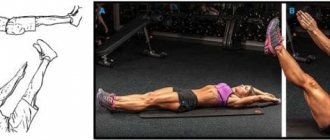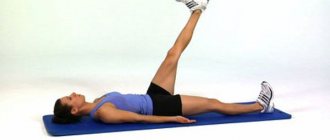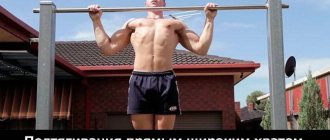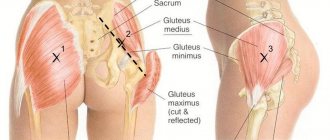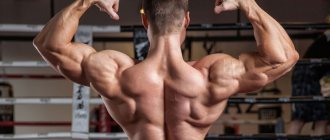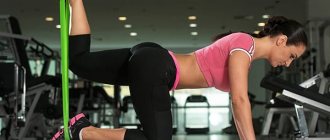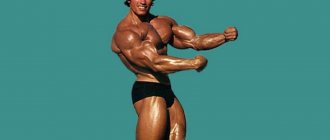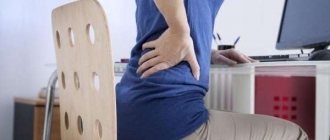Push-ups are bodyweight strength training that are key to developing upper body muscles. Regular push-ups not only improve your endurance and strengthen specific muscle groups, but also help tone your entire body.
.
Do you want to learn how to do push-ups, look for a ready-made pattern and the correct push-up technique?
Or do you just want to know more about the effectiveness of this exercise?
I offer you the most comprehensive guide to push-ups in the article, as well as step-by-step instructions on how to learn push-ups from scratch.
Advantages and disadvantages
Benefits of push-ups
- Multi-joint exercise , which allows you to work several muscle groups without additional weights, with your own weight.
- The exercise can be performed anywhere - the gym or at home, and does not require much time and space.
- There are practically no contraindications to performing the exercise and it can be performed at any age. Only with spinal problems is it necessary to control the deflection of the lower back and keep your back straight so as not to aggravate the problem.
- You can do push-ups with any level of physical fitness , from beginner to experienced athlete, depending on the type of exercise chosen.
Flaws
- The exercise is not suitable for gaining muscle mass, since its complexity will not allow you to get the proper load with a small number of repetitions, with the exception of the option of push-ups with weights.
- At first, not everyone can do push-ups with their own weight on the floor; for this it is necessary to prepare the body and strengthen the muscles with preparatory exercises.
Diagnosis of pathology
Very often, a qualified specialist can diagnose angina pectoris based only on the patient’s complaints. To confirm the diagnosis, there are several examination methods:
- An electrocardiogram (ECG) is one of the simplest, most accessible and informative methods for diagnosing pathology. The most informative ECG results will be those taken directly during the attack.
- A stress test is an examination that combines bicycle ergometry, a cold test, etc. In this case, the patient is given conditions of physical activity, during which the oxygen demand of the heart muscle increases, which makes it possible to determine the presence of coronary artery disease during exercise.
- Heart ultrasound is performed to assess the functioning of the heart valves and determine heart rhythm disturbances, which can in a certain way influence the development of cardiac ischemia.
- The coronary angiography method is the most accurate method for determining coronary heart disease. This diagnostic method can be prescribed by the attending physician based on the examination completed.
If a person, after doing push-ups or jogging, feels that he has pain behind the sternum, he should definitely undergo an examination. You should not self-medicate or leave things to chance: the sooner the problem is identified, the more effective and cheaper the treatment will be.
Types of push-ups: how to do push-ups on the floor correctly
There are several types of push-ups of varying degrees of difficulty, each of them can be performed at different stages of training. Follow proper push-up technique.
Classic wide grip chest push-ups
The most popular version of push-ups, which develops the chest muscles in width, its outer part.
- Place your arms wide apart from each other, place your hands parallel to each other.
- Place your feet the width of your pelvis.
- Get into a plank position by tightening your abdominal muscles, keeping your lower back straight in relation to your entire torso.
- Bend your elbows and lower your chest as far as possible to the floor. Elbows “look” to the sides.
- Extend your elbows completely at the top.
Narrow push-ups (grasshopper)
The closer the palms are placed, the more the inner part of the pectoral muscle works, the more the muscles closer to the center work. The narrow position puts a lot of tension on the triceps and is one of the best options for working it out.
- Place your palms under your shoulder joints, your hands parallel to each other.
- Take a plank position, draw in your stomach, continue to breathe continuously.
- Lower your torso to the floor without bending your knees, bring your elbows as close to your torso as possible.
- Push up, fully straighten your elbows at the top without arching your lower back.
Diamond push-ups
The exercise is so named due to the placement of the palms in the shape of a diamond, and it is also called diamond push-ups (from the English Diamond Push up), or diamond push-ups. With the help of a narrow position of the arms, diamond push-ups work the triceps to a greater extent, and the pectorals and deltoids to a lesser extent.
- Place your palms close to each other with your fingers facing inward, forming a cone or diamond.
- Place your thumbs together, palms should be under your chest.
- With your feet hip-width apart, stand in a plank position and keep your spine straight.
- Lower yourself to the lowest point, bending your elbows without moving them away from your body.
- Return to the starting position, fully straightening your arms.
Snake push-ups
- Lower your torso toward the floor, bending your elbows.
- During subsequent push-ups, roll from hand to hand.
- Do an equal number of rolls to the right and left.
Push-ups on fingers
This type of technique requires a strong grip and fingers. It is better to start mastering push-ups on your fingers after mastering the classic version.
- Place your hands wide, without your palms touching the floor, resting on the phalanges of your fingers, placing them wide apart from each other.
- Lower your body until the angle at your elbows reaches a right angle.
- At the top point, fully straighten your arms.
Push-ups
- Take a lying position, keeping your back straight.
- Place your hands wide apart on your fists, placing your hands in a straight line, perpendicular to your body.
- Lower your body, forming a right angle at your elbows.
- When doing push-ups, exhale and straighten up.
Knee push-ups
This type of exercise can be performed with different palm positions. This is a lightweight version of the exercise if it is still difficult to hold the emphasis while lying down.
- Place your knees together on the floor, forming a straight line from your knees to the top of your head.
- Lower your chest as low as possible to the floor.
- At the top, fully straighten your elbows without lifting your knees from the floor.
Army push-ups
- Place your feet together, palms slightly wider than shoulder-width apart.
- Raise your pelvis to form a 90-degree angle.
- Lower your nose as low as possible to the floor.
- Straighten your elbows, keeping a right angle.
Plyometric push-ups with cotton
- Take a lying position with your hands slightly wider than your shoulders.
- Lower your chest to the floor, explosively push your torso up so that your arms come off the floor.
- When you lift your palms, clap and return your palms to the floor by your sides.
- Repeat push-ups, pushing off the floor as hard as possible.
Roll-up push-ups
- Take a lying position, move your feet one step forward, rolling your body over your hands.
- Push up and move one step further.
- After doing 3-4 roll-ups and push-ups, take steps back, after each step do push-ups, and so on.
Weighted push-ups
- Take a lying position, adopting any position of your palms.
- Ask an assistant or trainer to place a plate of the required weight on your back.
- Perform the same exercise technique as with your own weight.
- After completion, ask to remove the weight from your back.
Superman push-ups
- Take a lying position, as in push-ups with clapping, use explosive force.
- Lower your body lower to the floor and with great force push your body so that your hands and feet come off the floor.
- At this moment, extend both arms in front of you as if you were flying.
- Return your palms and feet to the floor and repeat the push-up.
Spartan push-ups
- Stand in a plank position, place one hand farther forward from you, and the other closer to your waist.
- Lower your torso to the floor, when doing push-ups, forcefully push off the floor and swap your hands in the air.
- Repeat the required number of push-ups, changing hands.
T-push-ups with dumbbells
- Use dumbbells as push-up supports.
- Place your feet hip-width apart and your palms slightly wider than your shoulders.
- Lower your chest to the floor, to the level of the dumbbells, push up and turn your body to the right, raising your right arm with the dumbbell up (into the side plank).
- Lower your hand to the floor, do a push-up and do the same movement on your left hand.
You're fixated on moving up
Yes, this exercise is called a “push-up,” but this does not mean that you should concentrate only on straightening your elbows and neglect everything else. If done correctly, the downward movement also works to develop muscles and increase your strength.
How to fix it
At the top of the push-up, press your hands hard, as if there is a layer of sand scattered on the floor and you want to drown your palms in it. This way you will use the latissimus dorsi muscle, which you will use to the fullest extent, bending your elbows and lowering yourself down. The latissimus is the largest muscle in your back, and if you use it correctly, it will not only help you lower down effectively, but also push off the floor harder.
How to replace push-ups?
If you compare the working muscles during push-ups with other exercises, you can draw a parallel with some exercises with weights, for example, bench press, dumbbells or in a machine. In addition, after the muscles get used to push-ups, you can replace them with presses and progress further. But push-ups cannot be completely replaced, since when performing exercises while lying down, the stabilizer muscles do not work, which additionally work during push-ups, keeping the spine straight.
You're putting your arms too wide
The wider you spread your arms, the easier this exercise becomes. Notice that if you want to cheat, you don’t hesitate to spread your arms as if you want to hug Gerard Depardieu. With your arms spread out, push-ups are easier because this reduces the distance from your chest to the floor.
How to fix it
Place your palms exactly shoulder-width apart. This will help you keep your elbows tucked in while working your pecs and triceps at the same time. This makes the exercise harder, but if you do it this way, after a few months you will definitely notice the result.
My lats hurt after doing push-ups
Young specialist
Group: Users Messages: 617 Registration: 20.7.2007 From: Kamesnk User No.: 677 Thanks said: 2 times
A back injury forced me to miss the gym last week. To compensate for the lack of exercise on Monday, Wednesday and Friday, I did push-ups. I did 4 sets of 25 push-ups and 1 last one – 35 times. Assessing the subsequent effect, I would like to note that we completely undeservedly do not pay due attention to this exercise. After the first day of push-ups, I felt that my chest, lats, front deltoids and abs were sore. Having analyzed the mechanics of the exercises, I identified the following muscle groups that actively work during push-ups: 1 - Pectoral muscles - similar to the bench press. 2 - Latissimus dorsi muscles - I don’t quite understand how they are connected to the exercise, but the pain the next day is obvious. 3 - Triceps - everything is obvious with this one. 4 - Front delts - everything is also clear.
In addition, the following are involved: 1 - Press - to maintain a straight body position in opposition to the force of gravity. 2 - Quadriceps - similar to the press for straightening the legs, which tend to bend at the knee. 3 - Lower leg muscles (calves, etc.) - engaged as the feet are planted on the floor.
So this exercise is basic. When performing it, almost all the muscles of our body work.
What do you think about this?
Experienced
Group: Users Messages: 400 Registration: 27.7.2007 User No.: 733 Thanks said: 1 time
A back injury forced me to miss the gym last week. To compensate for the lack of exercise on Monday, Wednesday and Friday, I did push-ups. I did 4 sets of 25 push-ups and 1 last one – 35 times. Assessing the subsequent effect, I would like to note that we completely undeservedly do not pay due attention to this exercise. After the first day of push-ups, I felt that my chest, lats, front deltoids and abs were sore. Having analyzed the mechanics of the exercises, I identified the following muscle groups that actively work during push-ups: 1 - Pectoral muscles - similar to the bench press. 2 - Latissimus dorsi muscles - I don’t quite understand how they are connected to the exercise, but the pain the next day is obvious. 3 - Triceps - everything is obvious with this one. 4 - Front delts - everything is also clear.
In addition, the following are involved: 1 - Press - to maintain a straight body position in opposition to the force of gravity. 2 - Quadriceps - similar to the press for straightening the legs, which tend to bend at the knee. 3 - Lower leg muscles (calves, etc.) - engaged as the feet are planted on the floor.
So this exercise is basic. When performing it, almost all the muscles of our body work.
What do you think about this?
Young specialist
Group: Inactivated Messages: 608 Registration: 4.6.2007 From: Moscow User No.: 317 Thanks said: 1 time
A back injury forced me to miss the gym last week. To compensate for the lack of exercise on Monday, Wednesday and Friday, I did push-ups. I did 4 sets of 25 push-ups and 1 last one – 35 times. Assessing the subsequent effect, I would like to note that we completely undeservedly do not pay due attention to this exercise. After the first day of push-ups, I felt that my chest, lats, front deltoids and abs were sore. Having analyzed the mechanics of the exercises, I identified the following muscle groups that actively work during push-ups: 1 - Pectoral muscles - similar to the bench press. 2 - Latissimus dorsi muscles - I don’t quite understand how they are connected to the exercise, but the pain the next day is obvious. 3 - Triceps - everything is obvious with this one. 4 - Front delts - everything is also clear.
In addition, the following are involved: 1 - Press - to maintain a straight body position in opposition to the force of gravity. 2 - Quadriceps - similar to the press for straightening the legs, which tend to bend at the knee. 3 - Lower leg muscles (calves, etc.) - engaged as the feet are planted on the floor.
So this exercise is basic. When performing it, almost all the muscles of our body work.
Recommendations from athletes
V. Bondik, master of sports in weightlifting and powerlifting, personal trainer
Your results directly depend on the correct sequence of exercises during training. Also, you should not chase huge weights in the first stages of training; the back is a rather traumatic area, which will then require a long recovery period. Try to do the exercises as technically and slowly as possible, and add weight only after several workouts, doing it gradually.
Kh. Yakovenko, bodybuilder, fitness instructor
In my training practice, I often recommend using superset workouts for the back. Such exercises help to move from the “dead point” in progress and maximize muscle growth. The superset principle should be applied approximately 2 times a month, combining several exercises into one set. There is no need to feel sorry for yourself and take longer breaks - a maximum of 30 seconds to catch your breath.
S. Luchkina, L-sektor TRX training club trainer, fitness instructor
With the gradual pumping of the back muscles, the so-called “ossification” occurs - natural flexibility and overall mobility are lost. This is why it is so important to incorporate elements of stretching into your workouts - I recommend doing this for about 20 minutes after each strength session.
By stretching, you lengthen muscles, speed up recovery processes and help prevent many injuries.
Muscle pain after exercise
Here you will learn what causes muscle pain and how to get rid of it after training, how to remove lactic acid, important tips from experts.
Don’t you like doing heavy basic exercises when, after squats for up to 3 days, muscle pain after training prevents you from simply moving, or lifting a barbell for biceps causes painful sensations in your arms?! Then this article is definitely for you.
We will talk about lactic acid and its consequences - sore throat, how it develops and how to deal with it.
Muscle pain can occur after performing any exercise, but the example of squats with a barbell is the most obvious and understandable. Of course, you can simply exclude squats from the training program and replace them with others, there will be no pain and everything will be all right, but it is unlikely that without them you will gain decent mass and enormous strength in your legs.
You hang your head
This happens when your chest and arm muscles are tired. Hanging your head down while relaxing your neck muscles not only looks stupid, but can also cause injury. If you want to do push-ups for real, your chest should touch the floor, not your nose.
How to fix it
During push-ups, your body should form a clear line, from head to heels. If a mop stick was placed on your back, it would lie directly on the back of your head, back and buttocks. During push-ups, always stay straight, like in a plank.
source
What is sore throat?
Krepatura is a painful sensation in the muscles that occurs after loading them. There may be several reasons:
Muscles have not previously experienced stress
- The load was carried out after a long break of the trained muscles
- The load on the muscles is carried out from different, new angles
- Increased load on muscles
Answering the question of what soreness is, it should be said that it can be of varying degrees of pain for everyone, it depends on the length of training, the techniques used, the different sensitivity of the muscles to pain, etc.
It lasts from 12 to 48 hours after completing the workout and goes away gradually after 2-3 days. Muscle pain after training is a good pain, meaning that the body is not accustomed to the load, which means muscle growth is in the active stage, it is worse when there is a sharp pain during the exercise, in this case you need to stop it - either reduce the working weight, learn the correct technique, if it doesn’t help, replace the exercise.
Let's go further, how is soreness formed?
Cause of pain
Often the cause of the body's pain reaction is angina, and not just angina, but exertional angina. “Angina” is literally translated from Latin as “compression of the heart.”
This pathology is a form of coronary heart disease (CHD). Angina pectoris is characterized by attacks of severe pain that appear after playing sports or experiencing severe emotional stress. But there is also such a form as resting angina, which manifests itself with sudden attacks of pain when a person does not exercise.
This pathology has 4 functional classes:
- 1 FC – a person tolerates sports normally. Attacks appear only in cases of overexertion.
- 2 FC – a person’s physical activity is limited. The chest begins to hurt when moving, after walking more than 0.5 km, or when climbing stairs.
- 3 FC – limited physical activity is particularly pronounced. Pain in the chest appears when walking on level ground up to 0.5 km.
- 4 FC – attacks begin while walking at a distance of up to 100 meters.
In most cases, stopping physical activity relieves a person of pain, but resuming exercise again provokes a pain attack.
If the attack lasts longer than usual and the pain in the chest area is wave-like and with greater intensity, the pain is not relieved by an anesthetic or anti-inflammatory drug, you should immediately call an ambulance, because such symptoms are characteristic of the development of myocardial infarction.
Lactic acid after workout
Lactic acid after training is the main cause of muscle soreness. Our body synthesizes ATP (adesino triphosphate) through the breakdown of carbohydrates, the energy that is formed is used for high and medium intensity training.
As a result of this, fast and slow glycolysis is triggered; in the process of fast glycolysis, pyruvate (a salt of pyruvic acid) is formed, which is further formed into lactic acid.
In the process of accumulation of lactic acid, the acidity of cells increases, which slows down rapid glycolysis and the body
automatically produces less energy to lift weights and fatigue sets in.
Also, when muscle failure occurs, you feel a burning sensation in the muscles, this is due to the fact that lactic acid strongly irritates the receptors.
Lactic acid after training is our body’s self-defense from enormous overloads that can cause irreparable harm.
But there is one caveat: the concentration of lactic acid decreases after exercising the muscles for several hours, so why do the muscles hurt?
Scientists are not yet completely sure, but with a high degree of probability this is due to swelling of muscle tissue, due to the sudden arrival of leukocytes to heal micro-tears in muscles, so muscle pain after training is a normal, natural process.
How to get rid of muscle pain after training?
There are several simple and effective ways to do this:
1) Massage - it is effective, because by massaging the painful part, some of the leukocytes, which in large numbers have come to micro-tears, dissolve a little. It is believed that the massaged part reduces the feeling of pain by up to 30%.
2) Post-workout nutrition – no matter how funny it may seem, getting a sufficient portion of carbohydrates and protein after a workout leads to a decrease in the duration of muscle pain, and post-workout complexes will bring double the effect.
3) Bath with salt - half an hour in a bath with magnesium salt, it relaxes the muscles well, the salt soothes them, and hot water improves blood circulation and accelerates the delivery of nutrients to damaged areas.
4) Painkillers are medications like ibuprofen, analgin and the like; use them extremely rarely and temporarily, when the pain is simply unbearable and all other methods do not help.
Scientific evidence shows that they have a minimal effect on reducing muscle pain:
- applying ice packs
- muscle stretching before starting a workout
Over time, the body adapts to any type of load; your task is to constantly change it so that adaptation to the load is not frequent and does not cause a plateau (stagnation) effect.
You don't let your muscles relax
Tension in the muscles occurs when you “clog” them with high loads or a large amount of work. While this leads to muscle development, it can also lead to sharp pain if you don't relax properly. Have you ever seen a guy at the gym who bench presses for an hour and then walks around the bench with his shoulders pushed forward? This is because his pectoral muscles are overextended. The same thing can happen to you during push-ups.
How to fix it
Between sets, try doing a bridge on an exercise ball. This will stretch your core, chest, shoulders, and even your latissimus dorsi. Here's how to do it correctly: lower your head and the back of your head onto the ball and extend your arms so that they are perpendicular to your body. Lower your shoulders towards the floor. Stay in this position for 10 breaths.
Super exercises for improving shoulder tone
You use your shoulders countless times every day. You wash your hair, lift your children or grandchildren, open the car door - just think how difficult life will be if your shoulder muscles stop working.
You may know this first-hand, as 7.5 million people see a doctor every year because of shoulder problems. In addition, according to the American Committee on Physical Education, two out of three adults will experience some type of shoulder dysfunction during their lifetime.
The shoulder is a complex ball and socket joint that is used to expand, rotate, flex and more . It consists of three different muscles - the anterior, middle and posterior deltoid , which provide all these complex movements of the shoulder.
However, despite their importance and vulnerability to injury, many people forget to train their shoulders the same way they train other muscle groups - in the legs, core or arms.
But by building shoulder strength, you can help prevent common shoulder injuries and support optimal shoulder function throughout your life.
What exercises are best for your shoulders?
The American Exercise Science Committee teamed up with researchers from the University of Wisconsin Lacrosse Department of Clinical Exercise Physiology to determine which exercises are most effective specifically for the shoulder muscles.
After testing 10 common shoulder exercises, a few of the best were identified, depending on which of the three main muscles they targeted:
Standing Dumbbell Press: Best for the anterior deltoid, which is the muscle at the front of the shoulder.
45-degree press: Works best on the medial deltoid, although lateral raises have also proven effective.
Seated or 45-degree dumbbell flyes: Both of these exercises are effective for targeting the posterior deltoid and provide significant work on the muscles at the back of the shoulder.
In case you're wondering, other exercises that didn't make the top three for shoulders include push-ups, diagonal band extensions, dips, dumbbell front raises, cable exercises, and barbell rows. As Shape reports:
". Ultimately, there are many good exercises for working your shoulders, says John Pocari, Ph.D., director of clinical exercise physiology at the University of Wisconsin Lacrosse.
To make the most of your time in the gym, Porcari recommends doing standing dumbbell presses to target the front of the shoulder, combined with seated dumbbell flyes (because they're easier for most people)—or at a 45-degree angle to target the rear and middle deltoids." .
How to improve shoulder tone
If you're not planning on going to the gym, you can still significantly tone and strengthen your shoulders using a combination of bodyweight exercises, dumbbells and resistance bands.
The following exercises were developed by Jackie Dragon, director of FLEX Barre at FLEX Studios, and, according to New York magazine, "target not only the shoulders, but also the arms, even helping to reduce stubborn deposits of armpit fat .
Cross movements of the upper body
“Start in a plank position and, with your arms crossed, perform a push-up. Cross your arms again and do another push-up.”
Cross push-up while lying on your side
“Starting position: lying on your side. Place your left hand on the floor with your fingers pointing towards your head, and with your right hand hug the front of your waist. Using your left arm, straighten your left elbow and lift your upper body off the floor.”
Cross movements with dumbbells
“Squat down with your big toes spread in a plie position—a little wider than hip-width apart. [Hold a light dumbbell in each hand], making sure your shoulder is directly above your hip. Keep one hand motionless and move the other hand above and below the motionless hand. Switch hands and repeat."
Exercise with an expander to expand the chest
“Take a step forward by stepping on the resistance band so that the ends are even. Lower yourself into a small squat. Extend your arms to your sides and press them to your hips, being careful not to bend your elbows. You should feel an expansion in the front of your chest as you squeeze your shoulder blades together.”
Five exercises to relieve shoulder pain
Shoulder pain is often the result of repetitive movements that cause the soft tissue in the shoulder area to break down . Common culprits include sports such as tennis, throwing and weightlifting, but activities at work and even everyday activities such as washing windows or working in the garden.
Top-bottom: isolating loads for pumping different muscles from the shoulders to the lower back
- Shrugs. Take dumbbells of a suitable weight in your hands and stand as straight as possible. Inhaling, lift the dumbbells and pull them high, then return to the starting position. All movements must be performed slowly, without jerking and without the help of inertia.
- Block pull (bottom). Sit down on a special exercise machine and rest both legs on the supports (your knees should be slightly bent). Take the handles and, inhaling air, tilt your body forward - with an exhalation, pull the handles towards the belt line. Repeat 3 sets of 10 repetitions.
- Block pull (top). Sit down on a special exercise machine, secure your hips with the existing restraints. Grasp the handle and, as you exhale, pull it towards your chest line. Hold for a couple of seconds and while inhaling, return the handle to the starting position.
Note ! It is necessary to carefully monitor the position of your back, avoiding any deflection.
